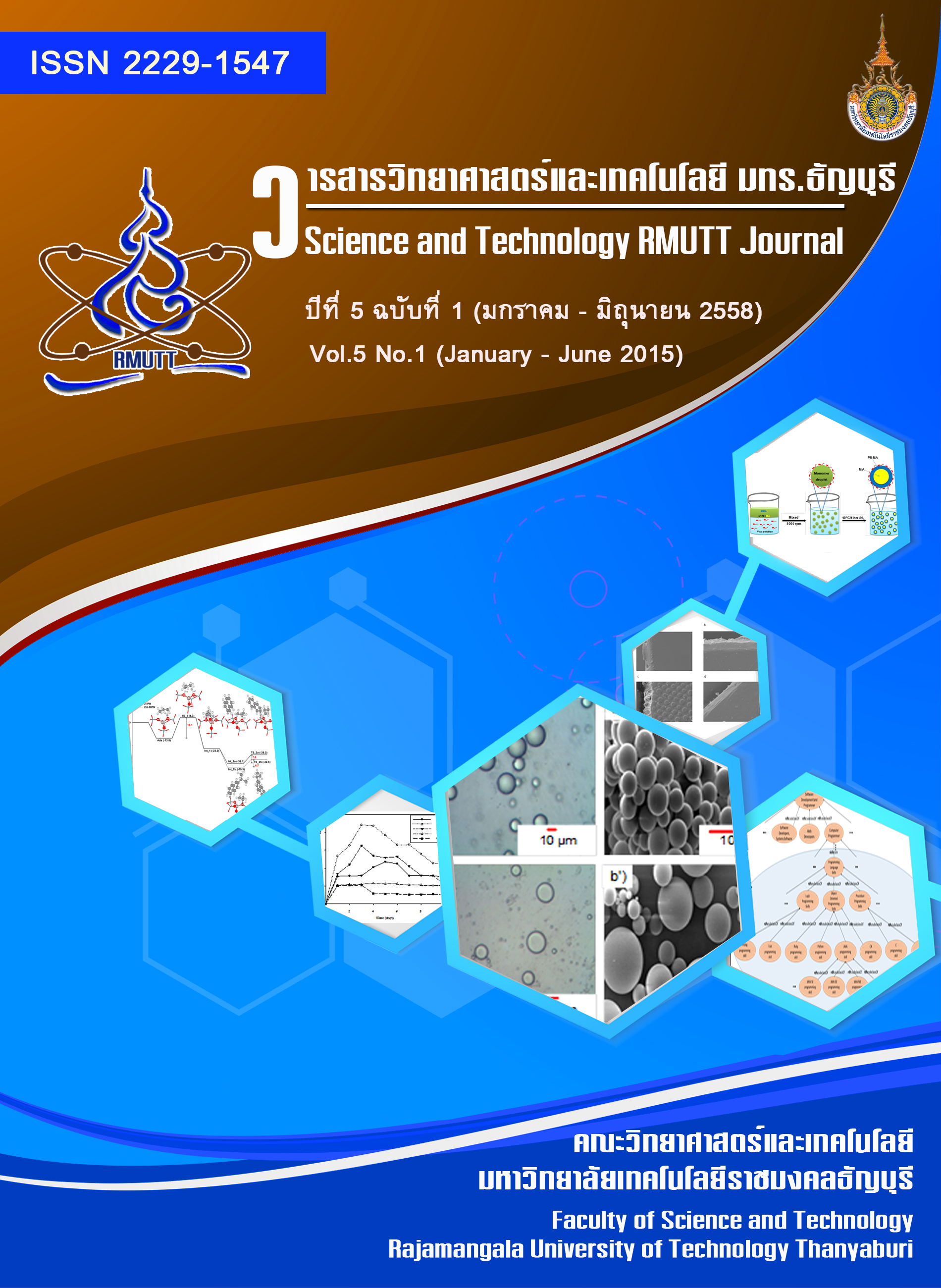Composition optimization and characterizations of poly(L-lactic acid)/cellulose acetate blends films in solvent mixture system
Main Article Content
Abstract
A biomaterial was developed by blending a commercially available poly(L-lactic acid) (PLLA) with cellulose acetate (CA) using a solvent casting technique. PLLA and CA have great potential for the manufacture of environmentally friendly thin films packaging but there is very limited number of studies on their blend compatibility. This work aimed to evaluate the compatibility of PLLA and CA in a solution form. The solution blends of various PLLA/CA weight percentages (0-100 %w/w) were prepared in a chloroform/acetone mixture solvent. Both physical and spectroscopic techniques were employed to characterize the homogeneity, structural integrity and various physicochemical properties of the films. Results indicated that PLLA was partially compatible with CA and the optically transparent films were only observed in either the PLLA- or CA-rich blend. However, this limit could be further extended by partial hydrolysis of the two polymers through the addition of hydrochloric acid. By altering some experimental conditions, a wide range of PLLA/CA films with different properties were fabricated. Interestingly, the Scanning Electron Microscopy (SEM) micrographs of the acid-free 40/60 blend film revealed the spherical agglomerated PLLA particles throughout the CA domain. Such embedded particles reinforced the thin film, as confirmed by the increased tensile strength comparing to that of the neat PLLA and CA films. This suggested the possible intermolecular interactions between the two components. The PLLA/CA blend system thus demonstrated its potential use for a wide range of applications, particularly in the manufacture of novel active biodegradable packing.
Article Details
References
R. Smith. Biodegradable Polymers for In dustrial Applications. Cambridge, Woodland Publishing, CRC Press; 2005. p 57-76.
M. Kolybaba, L.G. Tabli, S. Panigrahi, W.J. Crerar T. Powell and B. Wang. Biodegradable Polymers : Past, Present and Future. CSAE/ASAE Annual Intersectional Meeting. Fargo, North Dakota, USA. 2003.
L. Yu, K. Dean and L. Lin. Polymer blends and composites from renewable resources. Prog Polym Sci. 31 (2006): 576-602.
R. Auras, B. Hart and S. Selke. Polylactides A New Era of Biodegradable polymers for packaging application. ANTEC, (2006): 3240-3244.
V. Siracusa, P. Rocculi, S. Romani and R.M. Dalla. Trends in Food Science&Technology. 19 (2008): 634-643.
Y. Byunm, Y.T. Kim, and S. Whiteside. Characterization of an antioxidant polylactic acid (PLA) film prepared with –tocopherol, BHT and polyethylene glycol using gilm cast extruder. J. of Food Engi. 100 (2010): 239-244.
P.A. Gunatillake and R. Adhikari. Biodegradable synthetic polymers for tissue engineering. European Cells and Materials. 5 (2003): 1-16.
R. Herrero-Vanrell and M.F. Refojo. Biodegradable microspheres for vitreoretinal drug delivery. Adv.Drug Delivery Reviews. 52 (2001): 5-16.
R.A. Jarin. The manufacturing techniques of various drug loaded biodegradable po(lactide-co-glycolide)(PLGA) devices. Biomatrials. 21 (2000): 2475-2490.
M. Opaprakasit, W. KongTong, A. Petchsuk and P. Opaprakasit. Prosessability enhancement of poly(lactic acid-co-ethylene terephthalate) by blending with poly(ethylene-co-vinyl acetate), poly(hydroxybutyrate-co-3-hydroxyvalerate), and poly(butylenes succinate). Polym. Bull. 67 (2011): 275-290.
R.V. Tuil, P. Fowler, M. Lawther and C.J. Weber. Properties of Biobased Packaging Materials for the Food Industry: Status and Perspectives. Weber, CJ, Ed; Publisher: KVL: Frederiksberg, Denmark; 2000.
S.P. McCarthy. Advances in properties and biodegradability of continuous, immiscible, biodegradable, polymer blends. Macro.mol.Symp. 144 (1999): 63-72.
C. Bastioli. Biodegradable materials-Present situation and future perspectives. Macro.Mol.Symp 135 (1998): 193-204.
J. Tuominen, J. Kylma, A. Kapanen, O. Venelampi, M. Itavaara, and J. Seppala. Biodegradation of lactic acid based polymers under controlled composting conditions and evaluation of the ecotoxicological impact. Biomacromolecules. 3(3) (2002): 445-455.
B. Meng, J. Deng, Q. Liu, Z. Wu and W. Yang. Transparent and ductile poly(lactic acid)/poly(butyl acrylate)(PBA) blends: Structure and Properties. Eur Poly J. 48 (2011): 127-135.
M.B. Coltelli, S. Bronco and C. Chinea. The effect of free radical reactions on structure and properties of poly(lactic acid) (PLA) based blends. Polym Degrad Stab. 95 (2010): 332-341.
N. Bitinis, R. Verdejo, P. Cassagnau and M.A. Lopez-Manchado Structure and properties of polylactide/Natural rubber blends. Mat Chem and Phys. 129 (2011): 823-831.
C.M. Buchana, R.M. Gardner and R.J. Komarek. Aerobic biodegradation of cellulose acetate, J Appl Polm Sci. 47 (1993): 1709-1719.
R.J. Komarek, R.M. Gardner, C.M. Buchanan and S. Gedon. Biodegradation of radiolabeled cellulose acetate and cellulose propionate. J Appl Polym. Sci. 50 (1993): 1739-1746.
Y. Miyashita, T. Suzuki and Y. Nishio Miscibility of cellulose acetate with vinyl polymers, Cellulose. 9 (2002): 215-223.
K. Heamwichien, N. Nagasawa and M. Tamada. Effects of Radiation-Induced Crosslinking on the Thermal Stability of Poly(Lactic Acid) and Cellulose Acetate Blends. Proceeding of the Nuclear Science and Technology Conference 11st. Bangkok, Thailand. 2010.
N. Ogata et al Structure and Physical Properties of Cellulose Acetate/Poly(L-lactide) Blends. J Appl Polym Sci. 85(6) (2002): 1219-1226.
M.E. Broz, D.L. VanderHart and N.R. Washburn. Structure and mechanical properties of poly(D,L-lactic acid)/poly(ε-caprolactone) blends, Biomaterials. 24 (2003): 4181-4190.
X. Chuanhui, Y. Daosheng, F. Lihua and C.Yukun. Physical blend of PLA/NR with co-continuous phase structure: Preparation, rheology property, mechanical properties and morphology. Polymer Testing. 37 (2014): 94-101.
H. Tsuji and K. Suzuyoshi. Environmental degradation of biodegradable polyesters1. Poly(e-caprolactone), poly[(R)-3-hydroxybutyrate], and poly(L-lactide) films in controlled static seawater. Polym. Degrad. Stab. 75 (2002): 347-355.
M. Peesan, P. Supaphol and R. Rujiravanit. Effect of casting solvent on characteristics of hexanoyl chitosan/polylactide blend films. J Appl Polym Sci. 105 (2007): 1844–1852.
J. Ahmed, S.K. Varshney and R. Auras. Rheological and thermal properties ofpolylactide/silicate nanocomposites films. J Food Sci. 75 (2010): 17-24.
N. Olaru, A. Andriescu and L. Olaru On the hydrolysis of cellulose acetate in toluene/acetic acid/water system. Eur Polym J. 37 (2001): 865-867.
S.J. de Jong, E.R. Arias, D.T.S. Rijkers, C.F. Van Nostrum. Kettenes-van den Bosch JJ and Hennink WE. Polymer. 42 (2001): 2795-2802.
A.C. Renouf-Glauser, J. Rose, D. Farrar and R.E. Cameron. Biomaterials. 26 (2005): 2415-2422.
D. Garlotta. A literature review of poly(lactic acid). J Polym Environ. 9 (2002): 63-8.


